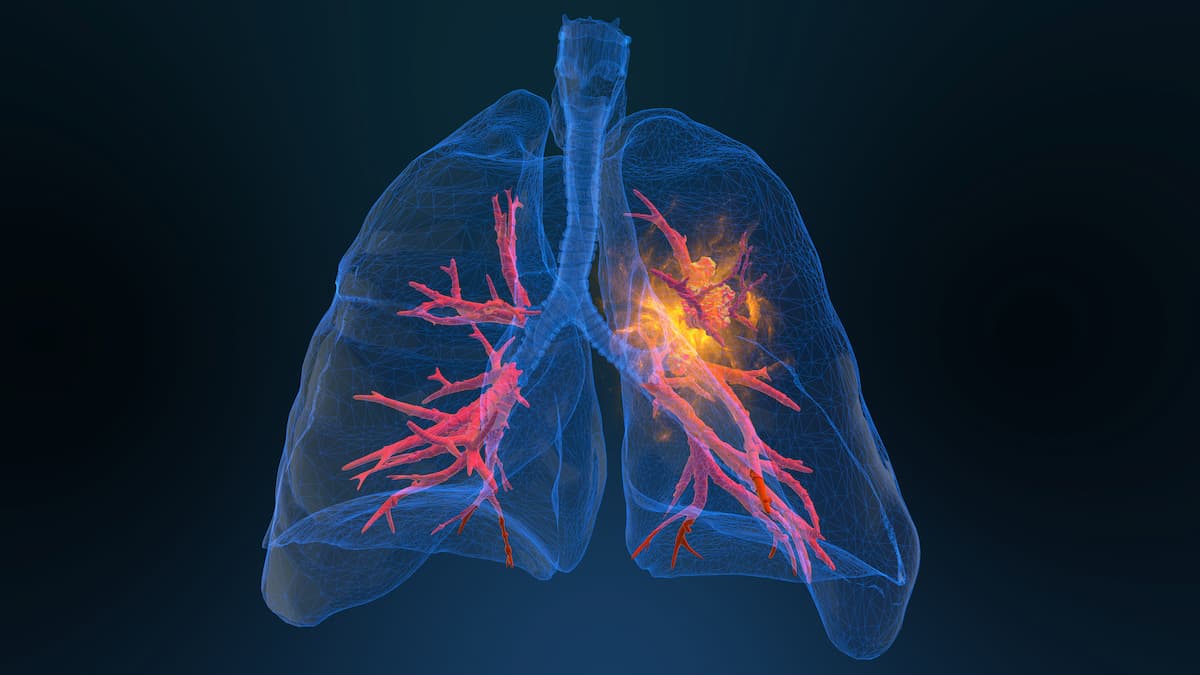DB-1310 Earns FDA Fast Track Designation in EGFR-Mutant Nonsquamous NSCLC
Support for the regulatory decision follows data from a phase 1/2a clinical trial assessing the agent in EGFR-mutant NSCLC at the 2025 ASCO Annual Meeting.
Among patients with EGFR-mutant NSCLC (n = 46), the ORR was 43.5%, with a confirmed ORR of 28.3%, after a median follow-up of 7.52 months.

The FDA has granted fast track designation to DB-1310, a next-generation HER3-targeting antibody-drug conjugate (ADC), for the treatment of patients with advanced, unresectable, or metastatic nonsquamous non–small cell lung cancer (NSCLC) with an EGFR exon 19 deletion or L858R mutation who experienced disease progression on or after treatment with a third-generation EGFR tyrosine kinase inhibitor (TKI) and platinum-based chemotherapy, according to a news release from the drug’s developer, DualityBio.1
Data from a first-in-human phase 1/2a trial (NCT05785741) assessing DB-1310 in advanced or metastatic solid tumors supported the agency’s decision. Results from the trial were presented in an oral session at the 2025 American Society of Clinical Oncology Annual Meeting.2
Efficacy data presented at the conference revealed that among 123 patients with advanced or metastatic solid tumors, the agent elicited an objective response rate (ORR) of 30.9%, including a confirmed ORR of 20.3%. The median duration of response (DOR) was 6.28 months (95% CI, 4.14-not evaluable [NE]), and the disease control rate (DCR) was 83.7%. The median progression-free survival (PFS) and overall survival (OS) were 5.49 months (95% CI, 4.30-6.93) and 14.42 months (95% CI, 10.68-NE), respectively.
Additionally, among patients with EGFR-mutant NSCLC (n = 46), the ORR was 43.5%, with a confirmed ORR of 28.3%, after a median follow-up of 7.52 months (range, 1.7-18.9). The median DOR was 5.80 months (95% CI, 2.73-NE), and the DCR was 91.3%. The median PFS and OS were 7.03 months (95% CI, 4.14-8.41) and 18.89 months (95% CI, 11.63-NE), respectively. Notably, among patients treated at the 5 mg/kg- (n = 16) and 5.5-mg/kg dose levels (n = 12), the confirmed ORR was 37.5% and 33.3%, respectively.
“DB-1310 demonstrated encouraging clinical efficacy and manageable safety in patients with [EGFR-mutant nonsquamous] NSCLC and multiple solid tumors. It is noteworthy that preclinical investigations of DB-1310 in combination with EGFR TKIs and other anticancer agents have also demonstrated robust synergistic tumor suppression activity,” Hua Mu, MD, PhD, global chief medical officer at DualityBio, said in the news release.1 “We will spare no effort to accelerate the clinical development of DB-1310 and look forward to its potential, as a next-generation HER3 ADC, to become a novel therapeutic option for a broad population of [patients with] cancer."
The phase 1/2a trial enrolled patients 18 years or older who were assigned to receive escalating doses of DB-1310 monotherapy in a 3+3 study design plus backfill starting at 1.5 mg/kg up to 6.5 mg/kg every 3 weeks. Backfilling at selected doses prioritized those with EGFR-mutant NSCLC.
Across all dose levels (n = 172), the median age was 61 years (range, 29-81). A total of 50.6% of patients were men, 65.1% were Asian, and 82.6% had an ECOG performance status of 1. The median number of prior lines of therapy was 3 (range, 1-11).
The primary end points of the trial were dose-limiting toxicities, maximum tolerated dose, and safety. Secondary end points included ORR, DCR, DOR, PFS, OS, pharmacokinetics, and antidrug antibodies.
Any-grade treatment-emergent adverse effects (TEAEs) were observed in 95.9% of patients. The incidence of grade 3 or higher TEAEs was 50.0%. A total of 88.4% of patients experienced treatment-related AEs (TRAEs), with 36.0% of patients experiencing TRAEs at grade 3 severity or greater.
TRAEs led to dose interruption in 15.1% of patients, dose reduction in 12.2% of patients, and treatment discontinuation in 3.5% of patients. The most common grade 1/2 TRAEs included nausea (37.8%), anemia (37.2%), platelet count decreases (26.8%), white blood cell count decreases (26.8%), and decreased appetite (25.6%). The most common grade 3 or higher TRAEs included neutrophil count decreases (20.9%), platelet count decreases (11.6%), white blood cell count decreases (8.7%), and lymphocyte count decreases (6.4%).
References
- DualityBio's next-generation HER3 ADC DB-1310 granted FDA fast track designation. News release. DualityBio. July 21, 2025. Accessed July 23, 2025. https://tinyurl.com/5ex7mueb
- Lisberg AE, Lu S, Hamilton EP, et al. DB-1310, a HER3-targeted ADC, in pts with advanced solid tumors: preliminary results from the phase 1/2a trial. J Clin Oncol. 2025;43(suppl 16):3000. doi:10.1200/JCO.2025.43.16_suppl.3000